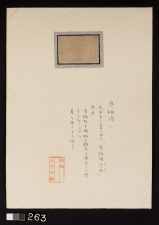Difference between revisions of "Kurumi (Walnut) - center (263 C)"
Jump to navigation
Jump to search
(username removed) |
(username removed) |
||
| Line 5: | Line 5: | ||
| 263 | | 263 | ||
|- | |- | ||
| − | ! scope="row"| | + | ! scope="row"|Uemura number / title |
| − | | | + | | ; "Haze-some 25" |
|- | |- | ||
! scope="row"|Folder location | ! scope="row"|Folder location | ||
| Line 44: | Line 44: | ||
| ash water | | ash water | ||
|- | |- | ||
| − | ! scope="row"| | + | ! scope="row"|Uemura's notes |
| − | | This color is what was called as "Kurumi-zome Kansan ( | + | | This color is what was called as "Kurumi-zome Kansan ()" in manuscripts () from the Tempyo period (729 - 749 AD), Japan. The resultant colors would be similar when dyed with leaves of this plant. |
|- | |- | ||
| − | ! scope="row"| | + | ! scope="row"|Uemura's date |
| Kyoto | | Kyoto | ||
|} | |} | ||
| − | [[Category: | + | [[Category:Uemura dye archive]] |
Revision as of 06:19, 24 July 2013
| Museum number | 263 |
|---|---|
| Uemura number / title | ; "Haze-some 25" |
| Folder location | 4th shelf |
| Sample location | center (263 C) |
| Fiber type | silk |
| Color | beigy pink |
| Dyestuff (Japanese common name) | 胡桃 : Kurumi |
| Dye (English common name) | Walnut tree |
| Dyestuff (botanical name) | Juglans mandshurica Maxim. var. sachalinensis (Miyabe et Kud) Kitam. (J. mandshurica var. sieboldiana (Maxim.) Makino) |
| Plant part | bark / dried (?) |
| Dyestuff extraction | boiled in water |
| Auxiliary agent in dye bath | - |
| Mordant | - |
| Other auxiliary agent | ash water |
| Uemura's notes | This color is what was called as "Kurumi-zome Kansan ()" in manuscripts () from the Tempyo period (729 - 749 AD), Japan. The resultant colors would be similar when dyed with leaves of this plant. |
| Uemura's date | Kyoto |
